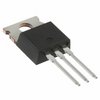Part Details for STF7N52K3 by STMicroelectronics
Results Overview of STF7N52K3 by STMicroelectronics
- Distributor Offerings: (2 listings)
- Number of FFF Equivalents: (0 replacements)
- CAD Models: (Request Part)
- Number of Functional Equivalents: (0 options)
- Part Data Attributes: (Available)
- Reference Designs: (Not Available)
Tip: Data for a part may vary between manufacturers. You can filter for manufacturers on the top of the page next to the part image and part number.
STF7N52K3 Information
STF7N52K3 by STMicroelectronics is a Power Field-Effect Transistor.
Power Field-Effect Transistors are under the broader part category of Transistors.
A transistor is a small semiconductor device used to amplify, control, or create electrical signals. When selecting a transistor, factors such as voltage, current rating, gain, and power dissipation must be considered, with common types. Read more about Transistors on our Transistors part category page.
Price & Stock for STF7N52K3
| Part # | Distributor | Description | Stock | Price | Buy | |
|---|---|---|---|---|---|---|
|
DISTI #
70389610
|
RS | MOSFET N-Channel 525V 6A TO220FP Min Qty: 10 Package Multiple: 1 Container: Bulk | 0 |
|
$0.8400 / $1.1600 | RFQ |
|
|
ComSIT USA | N-CHANNEL 525 V, 0.84 OHM, 6.3 A, TO-220FP SUPERMESH3 POWER MOSFET Power Field-Effect Transistor, 6.3A I(D), 525V, 0.98ohm, 1-Element, N-Channel, Silicon, Metal-oxide Semiconductor FET, TO-220AB ECCN: EAR99 RoHS: Compliant |
|
|
RFQ |
Part Details for STF7N52K3
STF7N52K3 CAD Models
STF7N52K3 Part Data Attributes
|
|
STF7N52K3
STMicroelectronics
Buy Now
Datasheet
|
Compare Parts:
STF7N52K3
STMicroelectronics
N-channel 525 V, 0.72 Ohm, 6 A, TO-220FP SuperMESH3(TM) Power MOSFET
|
| Rohs Code | Yes | |
| Part Life Cycle Code | Obsolete | |
| Ihs Manufacturer | STMICROELECTRONICS | |
| Part Package Code | TO-220AB | |
| Package Description | 3 PIN | |
| Pin Count | 3 | |
| Reach Compliance Code | not_compliant | |
| ECCN Code | EAR99 | |
| Samacsys Manufacturer | STMicroelectronics | |
| Case Connection | ISOLATED | |
| Configuration | SINGLE WITH BUILT-IN DIODE | |
| DS Breakdown Voltage-Min | 525 V | |
| Drain Current-Max (ID) | 6.3 A | |
| Drain-source On Resistance-Max | 0.98 Ω | |
| FET Technology | METAL-OXIDE SEMICONDUCTOR | |
| JEDEC-95 Code | TO-220AB | |
| JESD-30 Code | R-PSFM-T3 | |
| JESD-609 Code | e3 | |
| Number of Elements | 1 | |
| Number of Terminals | 3 | |
| Operating Mode | ENHANCEMENT MODE | |
| Operating Temperature-Max | 150 °C | |
| Package Body Material | PLASTIC/EPOXY | |
| Package Shape | RECTANGULAR | |
| Package Style | FLANGE MOUNT | |
| Polarity/Channel Type | N-CHANNEL | |
| Power Dissipation-Max (Abs) | 25 W | |
| Pulsed Drain Current-Max (IDM) | 25 A | |
| Qualification Status | Not Qualified | |
| Surface Mount | NO | |
| Terminal Finish | MATTE TIN | |
| Terminal Form | THROUGH-HOLE | |
| Terminal Position | SINGLE | |
| Transistor Application | SWITCHING | |
| Transistor Element Material | SILICON |
STF7N52K3 Frequently Asked Questions (FAQ)
-
The maximum junction temperature (Tj) for the STF7N52K3 is 175°C. However, it's recommended to operate the device within a safe operating area to ensure reliability and prevent thermal runaway.
-
To calculate the power dissipation, you need to consider the voltage drop across the device, the current flowing through it, and the thermal resistance (RthJA). The formula is: Pd = (Vin - Vout) x Iout x RthJA. You can find the thermal resistance values in the datasheet.
-
STMicroelectronics provides a recommended PCB layout in the application note AN5046. It's essential to follow the guidelines for copper pouring, thermal vias, and component placement to minimize EMI and thermal issues.
-
Yes, the STF7N52K3 is qualified for automotive and industrial applications. It meets the requirements of AEC-Q101 and IEC 60747-9 standards. However, it's essential to follow the recommended operating conditions, and ensure that the device is used within its specified ratings.
-
You can use external protection devices such as TVS diodes, zener diodes, or fuses to protect the STF7N52K3 from overvoltage and overcurrent conditions. Additionally, you can implement overcurrent protection using a sense resistor and a comparator.
